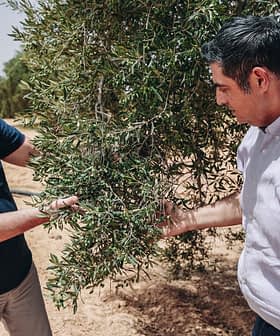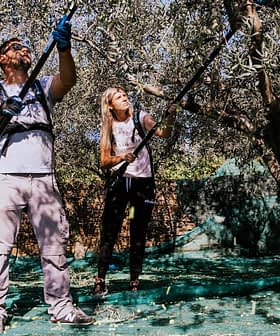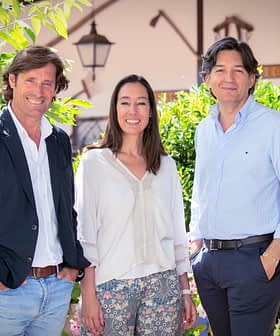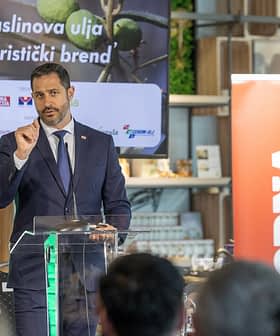Olive oil producers took part in a workshop at the IX festival in Split, Croatia’s second-largest city, to discuss the factors behind the success of Dalmatian oils on the global stage.
The festival, which celebrates locally-produced wine, olive oil, sheep cheese, prosciutto and other traditional foods, was held in the wine cellars of Diocletian’s Palace, built by the Roman emperor 1,700 years ago.
(The NYIOOC awards) encouraged (Dalmatian growers) because now they too are starting to receive the financial support that olive growers from Istria have had for a long time.
Seven of the 55 Dalmatian extra virgin olive oils awarded at the 2023 NYIOOC World Olive Oil Competition were at the workshop.
“It’s not an overnight success,” said workshop leader Mirela Žanetić, a well-known researcher from the Institute of Adriatic Culture in Split specializing in olive oil quality control and a local sensory analysis institute panel leader.
See Also:The Best Croatian EVOOs“Olive growing has always existed in Dalmatia,” she added. “It is passed down from generation to generation, so it is difficult to change traditional habits in the cultivation and processing of olives.”
“And the temperaments of Dalmatians are usually a bit more stubborn than the karst soils in which their olives grow,” she joked.
It took time for farmers to start thinking about what they do as a profession, a change that began 15 to 20 years ago.
Now, many advocates in the region believe olives are receiving the recognition and treatment they deserve, with olive growing on an undeniable upward trajectory.
This has been demonstrated by a growing number of young people restoring abandoned family olive groves and planting new ones.
Young people are interested in the combination of varieties and want to know everything about the oil they will produce. They increasingly rely on scientific research to guide their decision-making and apply agrotechnical measures from pruning, fertilization and crop protection to timely harvesting, olive processing and olive oil storage.
Young farmers have also been the driving force behind drawing numbers of producers entering local and international competitions to demonstrate their progress relative to their peers around the olive oil-producing world.
The meteoric rise of Croatian extra virgin olive oil on the world stage began three years ago when producers in Dalmatia and Istria, the country’s largest olive oil-producing regions, worked together to send a record number of entries to New York.
Croatian producers won 87 awards at the 2021 NYIOOC. Only Italy, Spain and Greece earned more awards than Croatia, which is home to slightly less than 4 million people.
“We were fourth,” said Tomislav Duvnjak, the young entrepreneur and award-winning producer behind Vodice DOO. He led the effort in Dalmatia to sample local extra virgin olive oils and raise funds to submit them to the NYIOOC.
Encouraged by this success, local organizations, county governments and regional chambers of commerce began to participate by co-financing the costs, which gave the Dalmatian olive groves an additional boost.
“It encouraged them because now they too are starting to receive the financial support that olive growers from Istria have had for a long time,” Žanetić said.
Increasing regional cooperation bore fruit at the 2022 NYIOOC, where Croatian producers earned 96 awards, only behind the olive-growing superpowers of Italy and Spain.
To put this success into context, Croatia has 19,000 hectares of olive groves with annual olive oil production of less than 5,000 tons. Meanwhile, Spain is home to 2.6 million hectares and produces an average of 1.3 million tons.
At the 2023 NYIOOC, Croatian producers earned a record-high 105 awards, with Dalmatian producers contributing 55. Once again, only Italy and Spain earned more awards.
“Until the very end of the competition, we were second, and then Spain overtook us by winning one more award,” Duvnjak said.
Žanetić added that based on success rate, the number of awards divided by entries, Croatia was the most successful country that submitted more than 10 extra virgin olive oils.
Back in the marble cellars of Diocletian’s palace, many festival visitors were also convinced of the quality of Dalmatian oils.
At a special workshop, Žanetić presented the seven award-winning Dalmatian oils: St. Ivan Vodice from Vodice, Laurenta from OPG Živković, Kota from Nadin, Clavis from OPG Glavina, Fortica from OPG Vlatkovic, Garden of Eden from TO Zvir on the island of Hvar and Zlatna Šoltanka, a cooperative of 20 growers from the island of Šolta.
“All these oils are extremely harmonious, complex and persistent,” said Žanetić, presenting them at the workshop. They are persistent and stable as their flavor stays in the mouth long after tasting.
During the tasting, Žanetić also answered questions about the secret of the success of Dalmatian oils.
“The secret is in the unique terroir (soil and land that emphasize the taste and smell of the native region where the oil is produced) and the autochthonous olive varieties,” she said.
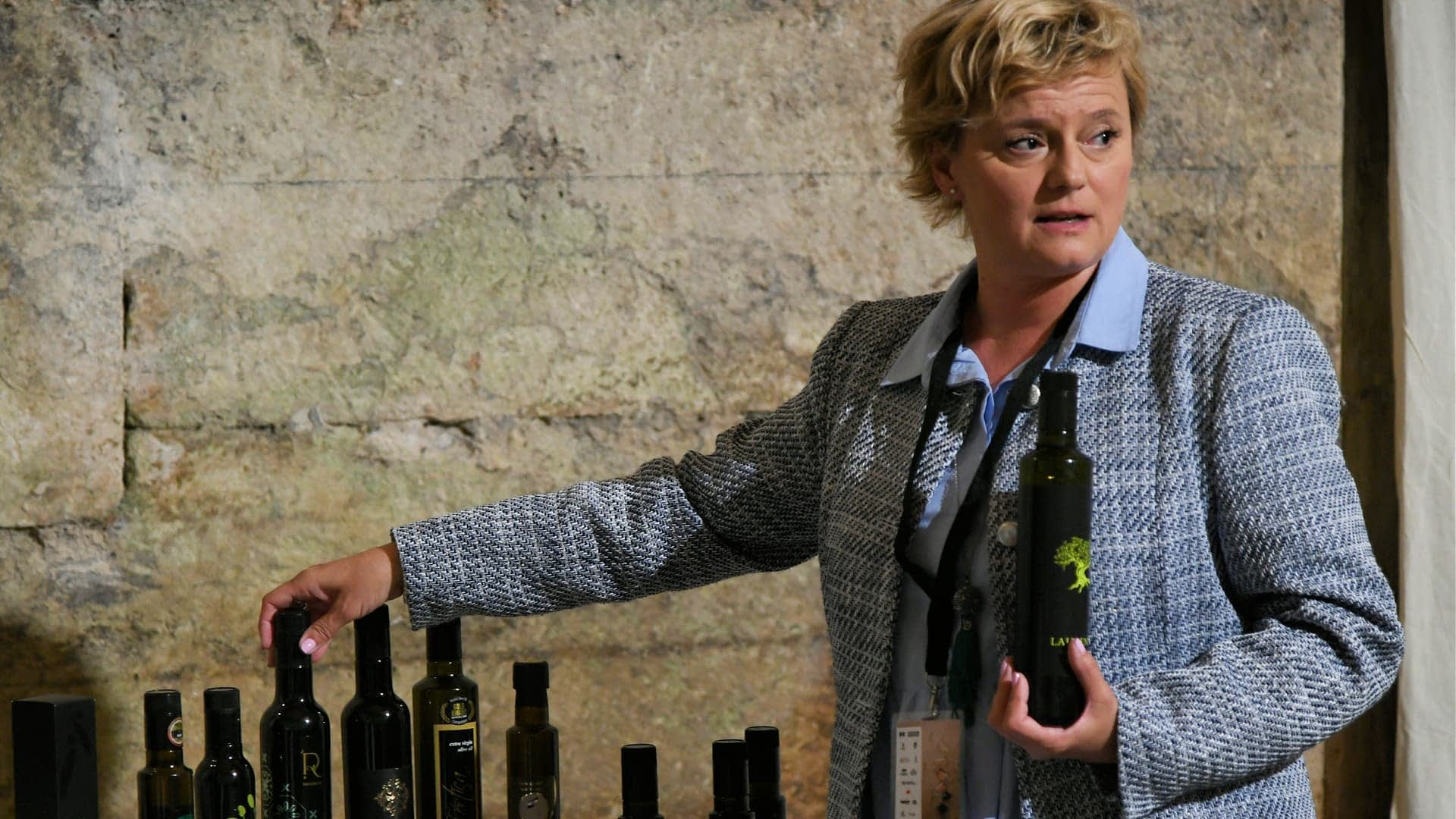
Mirella Žanetić
Many award-winning oils featured the Oblica olive variety, which tolerates extremely dry weather well. This variety produced healthy fruits with excellent fertility even after the drought during the 2022/23 crop year.
In these dry conditions, no diseases, especially peacock’s eye, or pests, such as the olive fruit fly, which usually cause extensive damage. Each female lays 50 eggs, one in each fruit.
Due to their rapid reproduction rate, an olive fruit fly infestation can destroy an entire crop. Infected fruits fall off even before oil production begins, so the damage is practically incalculable if this pest is not controlled in time, experts warn.
Despite the drought, last season was ultimately better than expected. What was harvested healthy and immediately processed was of top quality, which is especially evident in Oblica, which in dry conditions, when phenols increase, acquires more pronounced aromas, bitterness and spiciness.
Of the seven oils awarded at the NYIOOC 2023 presented at the workshop, three were monovarietal Oblicas, and one was a blend of Oblica and Levantinka.
Ahead of the 2023/24 crop year, Žanetić said, “the forecasts are ungrateful,” with heavy rains and flooding damaging some olive trees as they began to blossom.
However, producers remain optimistic that the olives that will grow will yield high-quality oil once again.
“We will send even more samples to New York than last year and achieve even greater success,” said Duvnjak, the unofficial selector of Dalmatian olive oil.
Putting aside the domestic rivalry between Istria and Dalmatia, Duvnjak said, “of all Dalmatian and Istrian oils, Croatian oils are the best.”


